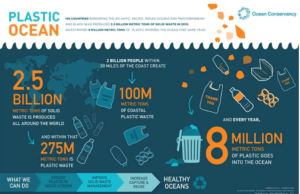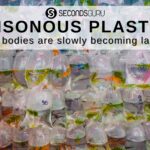Published 10 August 2022 ● Last Updated on 31 August 2022

From sterilised medical tools to microwave meals and affordable toys, the invention of plastic has changed our lives in ways both big and small. But the rate at which we’re consuming and discarding plastic – especially single-use products – is getting out of control and creating real problems for our oceans. Every year the International Coastal Cleanup (ICC) , a globally coordinated clean up of beaches and waterways, by Ocean Conservancy, is held on the 3rd Saturday of September. Till date 35 cleanups have seen 17 million volunteers clear 348 mil pounds(174,000 tons) of trash. How much do you know about the ubiquitous plastic in our oceans and waterways? Give this quiz a try and test your knowledge.

1. How many metric tons of plastic trash end up in the world’s oceans each year?
It is estimated that every year, 11 million metric tons of plastics enter our ocean. This is in addition to the estimated 200 million metric tons that are currently in circulation in our marine environments. This is equivalent to dumping one New York City garbage truck full of plastic into the ocean every minute of the day for an entire year!
2. By which year do scientists expect more than 70% of coral reefs to disappear?
It is expected that there would be a 70 to 90% decrease in live coral on reefs by 2050 due to warming ocean waters, ocean acidity, and pollution.
According to this report from 2020 – Status of Coral Reefs of the World, 14%of the world’s corals were lost between 2009 and 2018. However, the report notes that coral reefs are resilient and can recover if we take concrete steps to safeguard the marine environment and mitigate climate change.
3. The Great Pacific Garbage Patch (GPGP) is the largest accumulation of ocean plastic in the world , but it isn’t the only one, there are 3 other major vortexes of ocean plastic. Name them.
Trash collects and forms garbage patches all over the world’s oceans, this is the result of gyres. Gyres are large systems of circulating ocean currents, kind of like slow-moving whirlpools. They circulate the ocean’s waters around the globe and while doing so they also draw in and circulate the pollution that we release in coastal areas, known as marine debris.
There are three more distinct garbage patches that are not as big as GPGP but are significant nevertheless – The South Pacific Garbage Patch, The Indian Ocean Garbage Patch & The North Atlantic Garbage Patch
4. Studies show that as many as 50% of sea turtles are ingesting plastic at an unprecedented rate, and many are dying because of it. How many sea turtle species are listed as threatened or endangered?
There are 7 different species of sea turtles that call our oceans home. From the shallow seagrass beds of the Indian Ocean, to the colourful reefs of the Coral Triangle and the sandy beaches of the Eastern Pacific these turtles can be found scattered far and wide. While these highly migratory species periodically come ashore to either bask or nest, sea turtles spend the bulk of their lives in the ocean. Six of these species are threatened or endangered. They are Green, Hawksbill, Kemp’s Ridley, Loggerhead, Leatherback, and Olive Ridley.
Apart from plastic fishing nets hurting them (leaving some maimed for life) or capturing them fishing and getting entangled in plastic, climate change and habitat loss also affects these creatures.
5. With the exception of 2019 (report here) what is the most common marine debris collected at coastal cleanups during the annual International Cleanups worldwide?
Cigarette butts are the most common marine debris. Every year, 4500 billion cigarette butts are thrown on the ground around the world. This most common practice has heavy consequences – the wind or the rain carry the cigarette butts to the sewers or waterways before ending up in the ocean.
Most cigarette filters are made out of cellulose acetate, a plastic-like material that’s easy to manufacture, but not easy to degrade. The fibres in cigarette filters behave just like plastics in our oceans, the UV rays from the sun may break the fibres down into smaller pieces, but they don’t disappear. One solid filter ends up being thousands of tiny microplastics.
6. If we don’t start proactively reducing our plastic consumption and waste, by which year is it estimated that there will be more plastic than fish in the ocean by weight?
By 2050, plastic in the oceans will outweigh fish, predicts a report from the Ellen MacArthur Foundation, in partnership with the World Economic Forum. That’s 25 times heavier than the Great Pyramid of Giza. The report projects the oceans will contain at least 937 million tons of plastic and 895 million tons of fish by 2050.
7. What can you do to reduce plastic pollution in our oceans? List any 5!

Plastic pollution is rampant because of the increasing plastic production, low levels of recycling and poor waste management. However the solution to the pollution is yet at hand.
So, how did you fare in the overall quiz?
7: Expert alert. Take a bow.
4-6: Not bad. Give yourself a pat on the back.
<4: Kudos. You care enough to give the quiz a try. Thanks for caring!



0 Comments